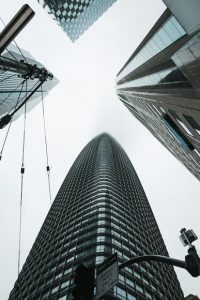The Market Cap Myth
Market cap is only a perception of value driven by price. Investors determine the price. Simply put, the price comes first, then market cap is derived after – not the other way around. So if the market were to price XRP at $100, THEN you can deduce the market cap to $5 trillion – but the price comes first. It doesn’t mean $5 trillion dollars of investments made the price $100. In fact, the Financial Industry Regulatory Authority (FINRA) posts this caution on their website regarding market cap: “Something important to keep in mind is that market cap is the perceived value of a company (perceived emphasized), because stock price is determined by investors. It isn’t necessarily the actual value of a company and all of its parts.”

Nicholas Cappello Stock Charts during a live trading session.
By Shawn B
Market Cap is irrelevant to any price action. There, I said it! Now let’s make one thing clear before I jump into this topic – I don’t support outrageous price quotes, but too many people in crypto misunderstand the usage of market cap in relation to pricing. It would seem that many have only come across the concept in their recent foray into the crypto world, made especially true and compounded by the fact that the top cryptos are ranked strictly by market cap. However, TL;DR, it’s a simplified – yet powerful – metric used in the buying and selling of traditional companies. It is wholly inappropriate in the context of crypto. If you care to dive more, here I go:
Let’s take one of the most popular and most often “hyper valuated” cryptos out there … XRP. There are often frequent calls for $10, $100, $589, $10,000, $35,000 XRP. A common, if not the most common refute to these quotes are “impossible, the market cap would have to be … insert number here). While I do not subscribe to these outlandish predictions, I hope to present a cogent argument for why market cap does not preclude these price values, and I’ll keep it simple with practical examples.
What is Market Cap?
What is market cap, anyway? According to Fidelity Investments, “Market cap—or market capitalization—refers to the total value of all a company’s shares of stock. It is calculated by multiplying the price of a stock by its total number of outstanding shares. For example, a company with 20 million shares selling at $50 a share would have a market cap of $1 billion. It allows investors to understand the relative size of one company versus another.” In other words, it’s an investment tool used to ballpark the size of companies for acquisition. Let’s take Twitter, for example. Elon Musk recently closed on his offer to buy Twitter for $44 billion on 27 October 2022. Twitter had roughly 800 million outstanding shares, for which Elon paid 54.20 each, totaling his $44 billion offer. In purchasing the entire company, he had to purchase every single outstanding share. In other words, every share holder will receive $54.20 for each share of Twitter they hold, and that will end their relationship with the company. This is possible in the construct of regular securities, since the company Twitter maintains hhhthe rights to the shares, and the shareholders have a representative of their ownership in the company as a stock. In essence, the company can (almost literally) commandeer and hand over each unit of stock representing ownership of the company.
Problem #1 – Obtaining The Entire Supply
In the case of cryptocurrencies, that is inherently impossible. Cryptos do not represent an ownership stake in the company, and each unit of cryptocurrency is wholly owned and custodied by the purchaser (or their designee in the case of cryptos on exchanges). This matters because it illustrates the impossibility of actually purchasing the entire supply of any cryptocurrency. So in the case of cryptos, “outstanding shares” would likely take a more literal meaning of those units or cryptocurrencies that have not yet been made available to the free market. In Bitcoin, this represents unmined coins; and in XRP, only those coins that Ripple has in escrow.
The entire supply of XRP is 100 billion. So if the price were to go to, say, $100, that would imply a market cap of $10 trillion. This is where people go crazy, but there are two failures with this valuation. The first is from Problem #1, where the coins already on the market are essentially off the table. They can’t be commandeered or purchased en masse, since no single entity owns them. This leaves only Ripple’s escrow of 50 billion XRP, which is the only thing that can be purchased en masse. Utilizing only Ripple’s escrow would chop that valuation in half to now $5 trillion.
Problem #2 – Moving A Market Cap
This brings me to problem #2, the amount of capital required to move the price is not directly proportionate to the market cap of the coin. Take this example from a comment I posted on TradingView in August 2021.
“If you go on Bittrex’s XRP/USD order book (this is from Monday, 31 Aug 21, you would see the total number of buys required to move XRP from $1.14 to $1.99 was only $1,600,000. That’s right, only $1.6 million to move the price to $2. Now, if that was the entire circulating supply of XRP, that would mean market cap at $1.14 is roughly 52 billion. At $1.99, market cap would now be roughly 92 billion – a change of $40 billion. So, in essence, if you had $1.6 million lying around and you were to buy all the buy orders on Bittrex, you could move the market cap by $40 billion! In plain speak, you just used ONLY 0.004% of $40 billion dollars to actually move the market cap by $40 billion.”
“From the example above, and a “mythical” price of $500: Yes, that’s a $23 trillion market cap, but it doesn’t mean that you need $23 trillion to get it there. If you use that same dumb 0.004%, it would only take $920 million to get it there – less than 1 billion dollars – and we all know there’s more than $1 billion in crypto. After all, Tesla bought $1.5 billion in Bitcoin in one go. So is it impossible to think that collectively, there can’t be a $1 billion investment into XRP in the very near future?”
Here’s the same concept from a traditional market perspective:
“All the physical cash circulating in the world today amount to about 36 trillion, while the amount of investments in the world is 1.2 quadrillion. So the question is, how come there is 1.2 quadrillion worth of investments when there is only 3% of that in available money in the whole world? Same theory can apply here, yes XRP can be valued at 5 trillion, but it doesn’t mean there’s 5 trillion dollars invested into it. In fact, if only 3%, it would only take 150 billion to give XRP a valuation of 5 trillion.“
Problem #3 – The Limitations of Market Cap
Market cap is only a perception of value driven by price. Investors determine the price. Simply put, the price comes first, then market cap is derived after – not the other way around. So if the market were to price XRP at $100, THEN you can deduce the market cap to $5 trillion – but the price comes first. It doesn’t mean $5 trillion dollars of investments made the price $100. In fact, the Financial Industry Regulatory Authority (FINRA) posts this caution on their website regarding market cap: “Something important to keep in mind is that market cap is the perceived value of a company (perceived emphasized), because stock price is determined by investors. It isn’t necessarily the actual value of a company and all of its parts.”
In conclusion, market cap is NOT a representation of what the market has actually invested into the company. It is NOT an indication of the amount of money that is pumped into any asset. It is NOT an indication of how much money is required to actually move the price. The amount of money required to move a coin’s price isn’t proportionate to the perceived value of the entire circulating supply. And, you cannot obtain the entire supply of any one coin. Furthermore, it is not a reliable metric for crypto outside of nominal rankings. Market cap is truly only a reflection of what the market thinks a company is worth, not necessarily what they ARE worth.
FINRA Market Cap Explained: https://www.finra.org/investors/insights/market-cap








